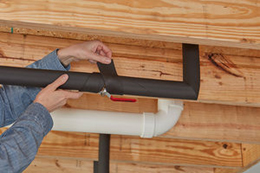The main function of insulation is to reduce heat loss in the system. If you have a problem with pipes freezing anywhere in your home, adding insulation helps keep the temperature of the liquid in the pipe above the freezing point.
However, the problem is not only in freezing. Especially in the summer months in substandard rooms, thermal insulation will help to keep cold tap water. Insulation can also provide additional protection against condensation, especially in high humidity conditions. In these hard-to-reach places, condensation may accumulate, which may eventually go unnoticed, which will lead to significant water damage, as when a frozen pipe breaks.
What good insulation should I use?
Any material with low thermal conductivity will work well as an insulator. Rubber insulation or insulation made of foamed polyethylene a, unlike fiberglass, is a closed-pore structure that acts as a built-in vapor moderator (shell) that prevents the penetration of moisture.
Closed-pore insulation materials, such as Oneflex rubber insulation, prevent condensation, moisture penetration and loss of thermal efficiency. This product is versatile, and they are easy to work with in a confined space. It does not contain fibers and does not cause discomfort like fiberglass insulation. Oneflex is ideal for working in cold climates, as it remains flexible at temperatures up to -50 °C, and its excellent thermal conductivity and low permeability to water vapor make it extremely effective in preventing condensation.
 What kind of insulation is required to prevent heat loss?
What kind of insulation is required to prevent heat loss?
Choosing the right insulation thickness is crucial to slow down heat transfer to achieve long-term temperature control and condensation even under extreme conditions. As the insulation thickness increases, the prevention of heat loss disappears very quickly. Any additional insulation will reduce the efficiency of preventing heat loss and reduce costs. With 13 mm thick insulation, more than 70% energy savings can be achieved.
We recommend 9, 13 mm insulation on most residential pipelines.
Where to insulate?
Every section of plumbing in your home can benefit from insulation, but in some cases it cannot be installed if the walls have been sealed. There are areas in your home that need to be accessible, and they will definitely benefit from thermal insulation. The best place to start is water pipes in any substandard premises, such as a garage, utility room or basement with an open pipeline. It is important to insulate all exposed surfaces of pipelines, including valves and taps.
You can purchase Armacell Oneflex rubber pipe insulation from us to meet the specific needs of your project.
Available insulation thickness of 6 mm, 9 mm, 13 mm, 19 mm, 25 mm, 32 mm. Diameter from 6 to 114 mm.
Remember that choosing the right accessories (glue and tape) plays a crucial role during installation and ensures productivity!
